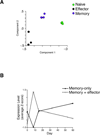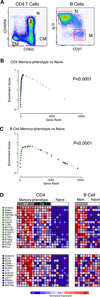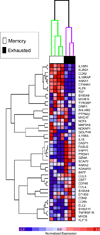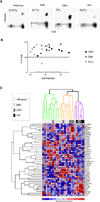Identification of an evolutionarily conserved transcriptional signature of CD8 memory differentiation that is shared by T and B cells
- PMID: 18641323
- PMCID: PMC3771862
- DOI: 10.4049/jimmunol.181.3.1859
Identification of an evolutionarily conserved transcriptional signature of CD8 memory differentiation that is shared by T and B cells
Abstract
After Ag encounter, naive lymphocytes differentiate into populations of memory cells that share a common set of functions including faster response to Ag re-exposure and the ability to self-renew. However, memory lymphocytes in different lymphocyte lineages are functionally and phenotypically diverse. It is not known whether discrete populations of T and B cells use similar transcriptional programs during differentiation into the memory state. We used cross-species genomic analysis to examine the pattern of genes up-regulated during the differentiation of naive lymphocytes into memory cells in multiple populations of human CD4, CD8, and B cell lymphocytes as well as two mouse models of memory development. We identified and validated a signature of genes that was up-regulated in memory cells compared with naive cells in both human and mouse CD8 memory differentiation, suggesting marked evolutionary conservation of this transcriptional program. Surprisingly, this conserved CD8 differentiation signature was also up-regulated during memory differentiation in CD4 and B cell lineages. To validate the biologic significance of this signature, we showed that alterations in this signature of genes could distinguish between functional and exhausted CD8 T cells from a mouse model of chronic viral infection. Finally, we generated genome-wide microarray data from tetramer-sorted human T cells and showed profound differences in this differentiation signature between T cells specific for HIV and those specific for influenza. Thus, our data suggest that in addition to lineage-specific differentiation programs, T and B lymphocytes use a common transcriptional program during memory development that is disrupted in chronic viral infection.
Figures






Similar articles
-
Memory T and memory B cells share a transcriptional program of self-renewal with long-term hematopoietic stem cells.Proc Natl Acad Sci U S A. 2006 Feb 28;103(9):3304-9. doi: 10.1073/pnas.0511137103. Epub 2006 Feb 21. Proc Natl Acad Sci U S A. 2006. PMID: 16492737 Free PMC article.
-
Transcriptional insights into the CD8(+) T cell response to infection and memory T cell formation.Nat Immunol. 2013 Apr;14(4):404-12. doi: 10.1038/ni.2536. Epub 2013 Feb 10. Nat Immunol. 2013. PMID: 23396170 Free PMC article.
-
Transcriptional and Epigenetic Regulation of Effector and Memory CD8 T Cell Differentiation.Front Immunol. 2018 Dec 7;9:2826. doi: 10.3389/fimmu.2018.02826. eCollection 2018. Front Immunol. 2018. PMID: 30581433 Free PMC article. Review.
-
Blimp-1 transcription factor is required for the differentiation of effector CD8(+) T cells and memory responses.Immunity. 2009 Aug 21;31(2):283-95. doi: 10.1016/j.immuni.2009.06.021. Epub 2009 Aug 6. Immunity. 2009. PMID: 19664942
-
Towards a cellular definition of CD8+ T-cell memory: the role of CD4+ T-cell help in CD8+ T-cell responses.Curr Opin Immunol. 2004 Jun;16(3):259-63. doi: 10.1016/j.coi.2004.03.004. Curr Opin Immunol. 2004. PMID: 15134772 Review.
Cited by
-
Expression of novel long noncoding RNAs defines virus-specific effector and memory CD8+ T cells.Nat Commun. 2019 Jan 14;10(1):196. doi: 10.1038/s41467-018-07956-7. Nat Commun. 2019. PMID: 30643116 Free PMC article.
-
Assessing the human immune system through blood transcriptomics.BMC Biol. 2010 Jul 1;8:84. doi: 10.1186/1741-7007-8-84. BMC Biol. 2010. PMID: 20619006 Free PMC article. Review.
-
Dual role of miR-21 in CD4+ T-cells: activation-induced miR-21 supports survival of memory T-cells and regulates CCR7 expression in naive T-cells.PLoS One. 2013 Oct 1;8(10):e76217. doi: 10.1371/journal.pone.0076217. eCollection 2013. PLoS One. 2013. PMID: 24098447 Free PMC article.
-
The multi-faceted immune modulatory role of S100A4 in cancer and chronic inflammatory disease.Front Immunol. 2025 Feb 26;16:1525567. doi: 10.3389/fimmu.2025.1525567. eCollection 2025. Front Immunol. 2025. PMID: 40078995 Free PMC article. Review.
-
BarWare: efficient software tools for barcoded single-cell genomics.BMC Bioinformatics. 2022 Mar 27;23(1):106. doi: 10.1186/s12859-022-04620-2. BMC Bioinformatics. 2022. PMID: 35346022 Free PMC article.
References
-
- Masopust D, Kaech SM, Wherry EJ, Ahmed R. The role of programming in memory T-cell development. Curr Opin Immunol. 2004;16:217–225. - PubMed
-
- Bertoletti A, Gehring AJ. The immune response during hepatitis B virus infection. J Gen Virol. 2006;87:1439–1449. - PubMed
-
- McMichael AJ. HIV vaccines. Annu Rev Immunol. 2006;24:227–255. - PubMed
-
- McHeyzer-Williams LJ, McHeyzer-Williams MG. Antigen-specific memory B cell development. Annu Rev Immunol. 2005;23:487–513. - PubMed
Publication types
MeSH terms
Grants and funding
LinkOut - more resources
Full Text Sources
Other Literature Sources
Research Materials

